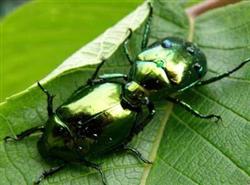Chrysanthemum planting techniques: what diseases and insect pests need to be controlled when planting chrysanthemums?

What diseases and insect pests need to be controlled in planting chrysanthemums? Please introduce the control methods of chrysanthemum diseases: the common diseases of chrysanthemum are black spot, powdery mildew and Fusarium wilt. In Shenzhen, the most serious disease of chrysanthemum is black spot. The disease occurs from the lower leaves of the plant, which appears brown spots at the beginning of the disease, then expands into round, oval or irregular disease spots, and in severe cases, the leaves turn black and die. The disease can occur in the whole growing period of chrysanthemum, especially in high temperature and rainy weather. The susceptible leaves of powdery mildew appeared yellow dots at the initial stage, and then gradually expanded and connected into pieces, and the diseased part was covered with white powdery mildew, that is, the fruiting body of the pathogen. The seriously susceptible leaves were twisted and deformed, withered and yellow fell off, and the disease occurred more frequently in spring and summer. Fusarium wilt: the above-ground leaves of the injured plant initially showed light leaf color, loss of luster, slightly wavy, wilting and drooping, slight swelling and browning at the base of the stem, rough epidermis, cracks, white mildew in the seams in severe cases, black and rotten roots, root hair shedding, harmful substances secreted by bacteria destroyed host cell tissue and blocked ducts, blocked water supply, and the plant wilted and died quickly. the disease occurred seriously in summer. The common pests of chrysanthemum are aphids and red spiders. Aphids are the main pests of chrysanthemum, the damaged part of the plant grows slowly, the leaves are curly and deformed, the seriously harmful plants yellowed and deformed, and the flower buds can not develop normally. In Shenzhen, April to May and September to October are the most harmful to autumn chrysanthemum. A large number of aphids are concentrated in the tender shoots, buds and leaf backs of chrysanthemum, causing great losses to chrysanthemum production. Red spiders often occur in the high temperature and dry season, lurking on the back of the leaves, sucking the leaf juice, making the leaves dry and yellow and withering, endangering the buds during flowering and causing the flowers to wither quickly. In order to do a good job in the integrated prevention and control of diseases and insect pests of chrysanthemum, there are three key points: first, strengthen fertilizer and water management, cultivate robust plants, and improve disease resistance. Second, prevention first, usually combined with production season and weather changes, timely use of drugs, comprehensive prevention and control. In the aspect of drug use, the mixed use of drugs can achieve better control effects, such as the mixed use of Haoshengling and Chlorothalonil, Haoshengling and Ruidui, which has a better control effect on chrysanthemum black spot and Fusarium wilt. Some insecticides can also be mixed with fungicides, which can not only achieve the effect of disease and insect control, but also save manpower. In addition, the application of carbofuran granules in the potted soil of chrysanthemum has a long-term control effect on piercing pests. Third, the early use of medicine, usually should be diligent observation. Once the signs of diseases and insect pests are found, the use of drugs for symptoms can often achieve better results, but once negligent, when the diseases and insect pests are serious, it will often get half the result with twice the effort, and greatly reduce the growth and ornamental value of chrysanthemums. Click for more chrysanthemum planting techniques click to get more flower planting techniques
- Prev

Chrysanthemum planting techniques: how to control beetles by planting chrysanthemums?
How to prevent and cure beetles by planting chrysanthemums? Please introduce the method: the beetle is a pest. Adults bite chrysanthemum leaves into reticular holes and lacerations, leaving only the main vein in serious cases, especially in the case of cluster damage. Often bite the most from evening to 10:00 in the evening. Larval grubs harm chrysanthemum seedlings and tender stems. Prevention and treatment methods:.
- Next

Chrysanthemum planting technique: how to control powdery mildew by planting chrysanthemum?
How to control powdery mildew by planting chrysanthemums? Please introduce the prevention and control of chrysanthemum powdery mildew by referring to the following methods: 1. In garden cleaning, attention should be paid to cutting off overdense and withered yellow leaves, pulling out diseased plants, cleaning diseased and residual leaves, concentrated burning or deep burial, which can greatly reduce the source of pathogen infection. 2. Strengthen production.
Related
- Fuxing push coffee new agricultural production and marketing class: lack of small-scale processing plants
- Jujube rice field leisure farm deep ploughing Yilan for five years to create a space for organic food and play
- Nongyu Farm-A trial of organic papaya for brave women with advanced technology
- Four points for attention in the prevention and control of diseases and insect pests of edible fungi
- How to add nutrient solution to Edible Fungi
- Is there any good way to control edible fungus mites?
- Open Inoculation Technology of Edible Fungi
- Is there any clever way to use fertilizer for edible fungus in winter?
- What agents are used to kill the pathogens of edible fungi in the mushroom shed?
- Rapid drying of Edible Fungi

